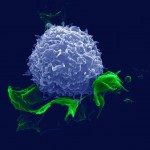Link to Pubmed [PMID] – 25617471
J. Immunol. 2015 Mar;194(5):2099-109
CD4(+)CD28(-) T cells arise through repeated antigenic stimulation and are present in diseased tissues of patients with various autoimmune disorders, including multiple sclerosis (MS). These cells are believed to have cytotoxic properties that contribute to the pathogenic damaging of the target organ. Endogenous cues that are increased in the diseased tissue may amplify the activity of CD4(+)CD28(-) T cells. In this study, we focused on IL-15, a cytotoxicity-promoting cytokine that is increased in the serum and cerebrospinal fluid of MS patients. Using immunohistochemistry, we demonstrate that IL-15 is mainly produced by astrocytes and infiltrating macrophages in inflammatory lesions of MS patients. Moreover, in vitro transmigration studies reveal that IL-15 selectively attracts CD4(+)CD28(-) T cells of MS patients, but not of healthy individuals. IL-15 further induces the expression of chemokine receptors and adhesion molecules on CD4(+)CD28(-) T cells, as investigated using flow cytometry, resulting in enhanced migration over a monolayer of human brain endothelial cells. Finally, flow cytometric analyses revealed that IL-15 increases the proliferation and production of GM-CSF, expression of cytotoxic molecules (NKG2D, perforin, and granzyme B), and degranulation capacity of CD4(+)CD28(-) T cells. Taken together, these findings indicate that increased peripheral and local levels of IL-15 amplify the pathogenic potential of CD4(+)CD28(-) T cells, thus contributing to tissue damage in MS brain lesions.

